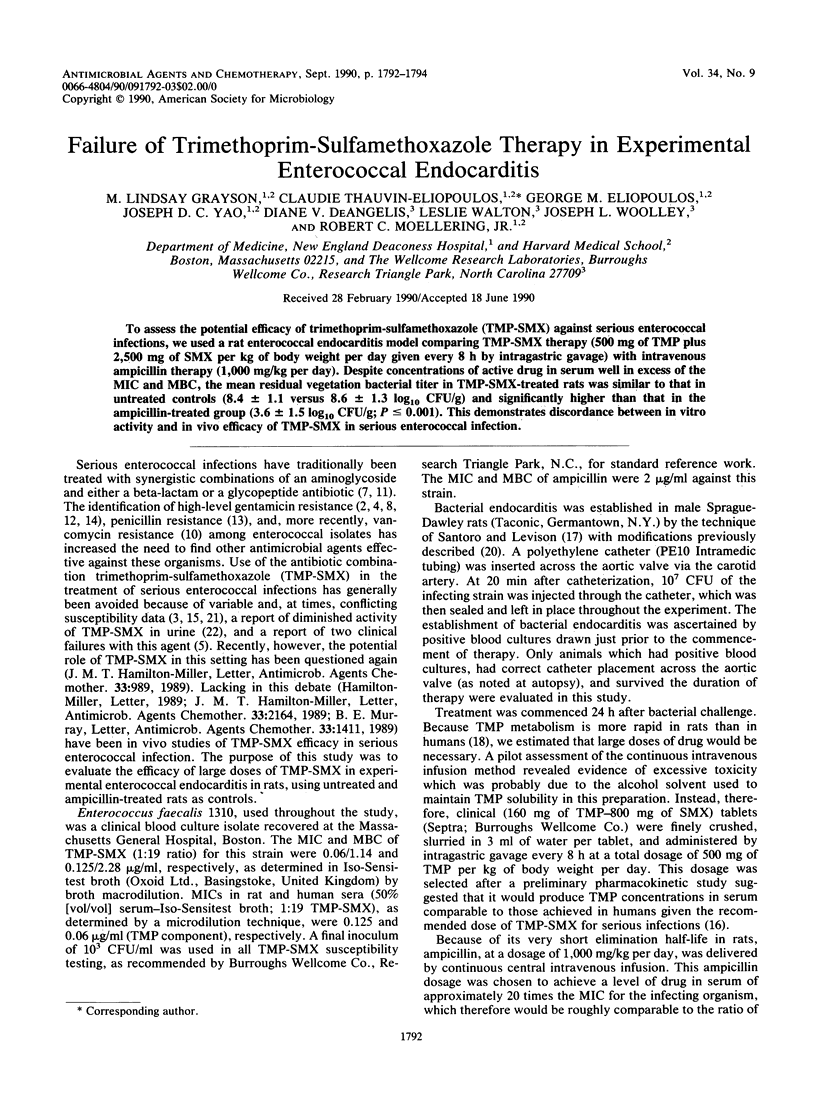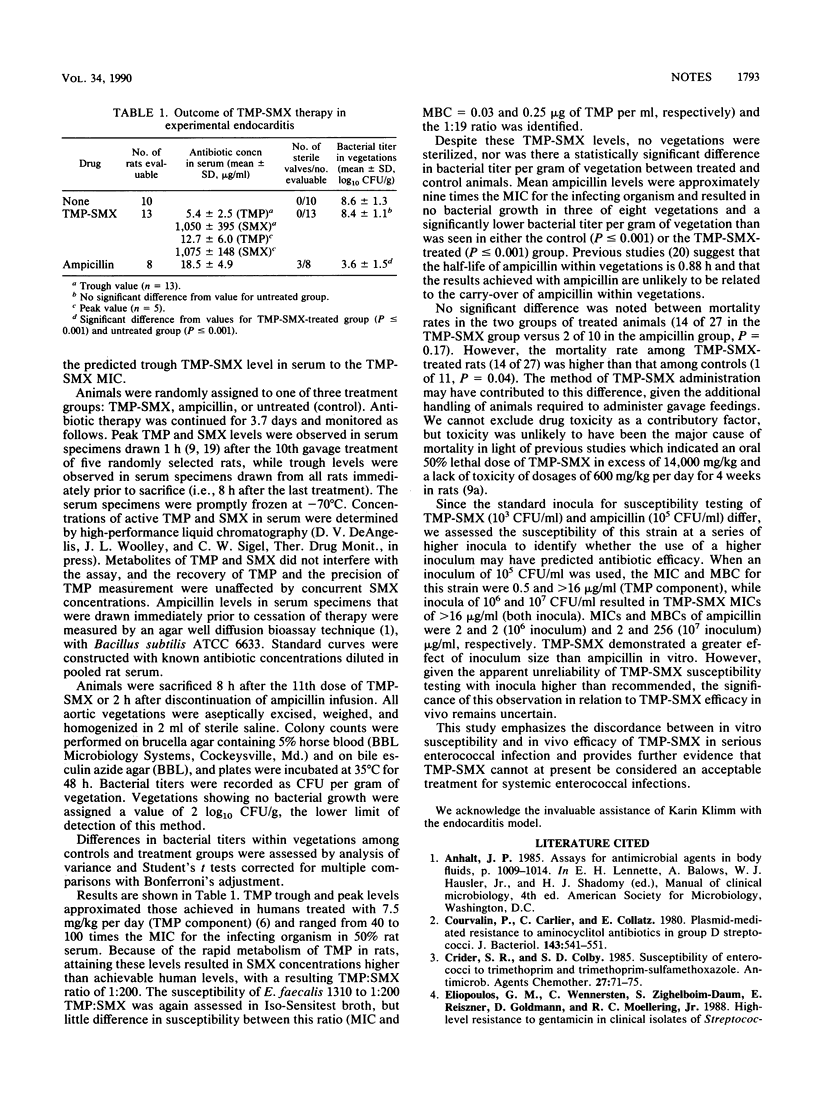Abstract
To assess the potential efficacy of trimethoprim-sulfamethoxazole (TMP-SMX) against serious enterococcal infections, we used a rat enterococcal endocarditis model comparing TMP-SMX therapy (500 mg of TMP plus 2,500 mg of SMX per kg of body weight per day given every 8 h by intragastric gavage) with intravenous ampicillin therapy (1,000 mg/kg per day). Despite concentrations of active drug in serum well in excess of the MIC and MBC, the mean residual vegetation bacterial titer in TMP-SMX-treated rats was similar to that in untreated controls (8.4 +/- 1.1 versus 8.6 +/- 1.3 log10 CFU/g) and significantly higher than that in the ampicillin-treated group (3.6 +/- 1.5 log10 CFU/g; P less than or equal to 0.001). This demonstrates discordance between in vitro activity and in vivo efficacy of TMP-SMX in serious enterococcal infection.
Full text
PDF


Selected References
These references are in PubMed. This may not be the complete list of references from this article.
- Courvalin P., Carlier C., Collatz E. Plasmid-mediated resistance to aminocyclitol antibiotics in group D streptococci. J Bacteriol. 1980 Aug;143(2):541–551. doi: 10.1128/jb.143.2.541-551.1980. [DOI] [PMC free article] [PubMed] [Google Scholar]
- Crider S. R., Colby S. D. Susceptibility of enterococci to trimethoprim and trimethoprim-sulfamethoxazole. Antimicrob Agents Chemother. 1985 Jan;27(1):71–75. doi: 10.1128/aac.27.1.71. [DOI] [PMC free article] [PubMed] [Google Scholar]
- Goodhart G. L. In vivo v in vitro susceptibility of enterococcus to trimethoprim-sulfamethoxazole. A pitfall. JAMA. 1984 Nov 16;252(19):2748–2749. [PubMed] [Google Scholar]
- Grose W. E., Bodey G. P., Loo T. L. Clinical pharmacology of intravenously administered trimethoprim-sulfamethoxazole. Antimicrob Agents Chemother. 1979 Mar;15(3):447–451. doi: 10.1128/aac.15.3.447. [DOI] [PMC free article] [PubMed] [Google Scholar]
- Hoffmann S. A., Moellering R. C., Jr The enterococcus: "putting the bug in our ears". Ann Intern Med. 1987 May;106(5):757–761. doi: 10.7326/0003-4819-106-5-757. [DOI] [PubMed] [Google Scholar]
- Horodniceanu T., Bougueleret L., El-Solh N., Bieth G., Delbos F. High-level, plasmid-borne resistance to gentamicin in Streptococcus faecalis subsp. zymogenes. Antimicrob Agents Chemother. 1979 Nov;16(5):686–689. doi: 10.1128/aac.16.5.686. [DOI] [PMC free article] [PubMed] [Google Scholar]
- Kuhne J., Kohlmann F. W., Seydel J. K., Wempe E. Pharmakokinetik der Kombination Sulfamoxol/Trimethoprim (CN 3123) bei Tier und Mensch. Arzneimittelforschung. 1976;26(42):651–657. [PubMed] [Google Scholar]
- Lagler F., Kretzschmar R., Leuschner F., Foitzik E., Kiel H., Kuhne J., Neumann W. Toxikologische Untersuchungen der Kombination Sulfamoxol/Trimethoprim (CN 3123), eines neuen Breitbandchemotherapeutikums. Arzneimittelforschung. 1976;26(42):634–643. [PubMed] [Google Scholar]
- Leclercq R., Derlot E., Duval J., Courvalin P. Plasmid-mediated resistance to vancomycin and teicoplanin in Enterococcus faecium. N Engl J Med. 1988 Jul 21;319(3):157–161. doi: 10.1056/NEJM198807213190307. [DOI] [PubMed] [Google Scholar]
- Maki D. G., Agger W. A. Enterococcal bacteremia: clinical features, the risk of endocarditis, and management. Medicine (Baltimore) 1988 Jul;67(4):248–269. [PubMed] [Google Scholar]
- Mederski-Samoraj B. D., Murray B. E. High-level resistance to gentamicin in clinical isolates of enterococci. J Infect Dis. 1983 Apr;147(4):751–757. doi: 10.1093/infdis/147.4.751. [DOI] [PubMed] [Google Scholar]
- Murray B. E., Mederski-Samaroj B. Transferable beta-lactamase. A new mechanism for in vitro penicillin resistance in Streptococcus faecalis. J Clin Invest. 1983 Sep;72(3):1168–1171. doi: 10.1172/JCI111042. [DOI] [PMC free article] [PubMed] [Google Scholar]
- Murray B. E., Tsao J., Panida J. Enterococci from Bangkok, Thailand, with high-level resistance to currently available aminoglycosides. Antimicrob Agents Chemother. 1983 Jun;23(6):799–802. doi: 10.1128/aac.23.6.799. [DOI] [PMC free article] [PubMed] [Google Scholar]
- Najjar A., Murray B. E. Failure to demonstrate a consistent in vitro bactericidal effect of trimethoprim-sulfamethoxazole against enterococci. Antimicrob Agents Chemother. 1987 May;31(5):808–810. doi: 10.1128/aac.31.5.808. [DOI] [PMC free article] [PubMed] [Google Scholar]
- Santoro J., Levison M. E. Rat model of experimental endocarditis. Infect Immun. 1978 Mar;19(3):915–918. doi: 10.1128/iai.19.3.915-918.1978. [DOI] [PMC free article] [PubMed] [Google Scholar]
- Schwartz D. E., Vetter W., Englert G. Trimethoprim metabolites in rat, dog and man: qualitative and quantitative studies. Arzneimittelforschung. 1970 Dec;20(12):1867–1871. [PubMed] [Google Scholar]
- Schwartz D. E., Ziegler W. H. Assay and pharmacokinetics of trimethoprim in man and animals. Postgrad Med J. 1969 Nov;45(Suppl):32–37. [PubMed] [Google Scholar]
- Thauvin C., Eliopoulos G. M., Willey S., Wennersten C., Moellering R. C., Jr Continuous-infusion ampicillin therapy of enterococcal endocarditis in rats. Antimicrob Agents Chemother. 1987 Feb;31(2):139–143. doi: 10.1128/aac.31.2.139. [DOI] [PMC free article] [PubMed] [Google Scholar]
- Tofte R. W., Solliday J. A., Crossley K. B. Susceptibilities of enterococci to twelve antibiotics. Antimicrob Agents Chemother. 1984 Apr;25(4):532–533. doi: 10.1128/aac.25.4.532. [DOI] [PMC free article] [PubMed] [Google Scholar]
- Zervos M. J., Schaberg D. R. Reversal of the in vitro susceptibility of enterococci to trimethoprim-sulfamethoxazole by folinic acid. Antimicrob Agents Chemother. 1985 Sep;28(3):446–448. doi: 10.1128/aac.28.3.446. [DOI] [PMC free article] [PubMed] [Google Scholar]


